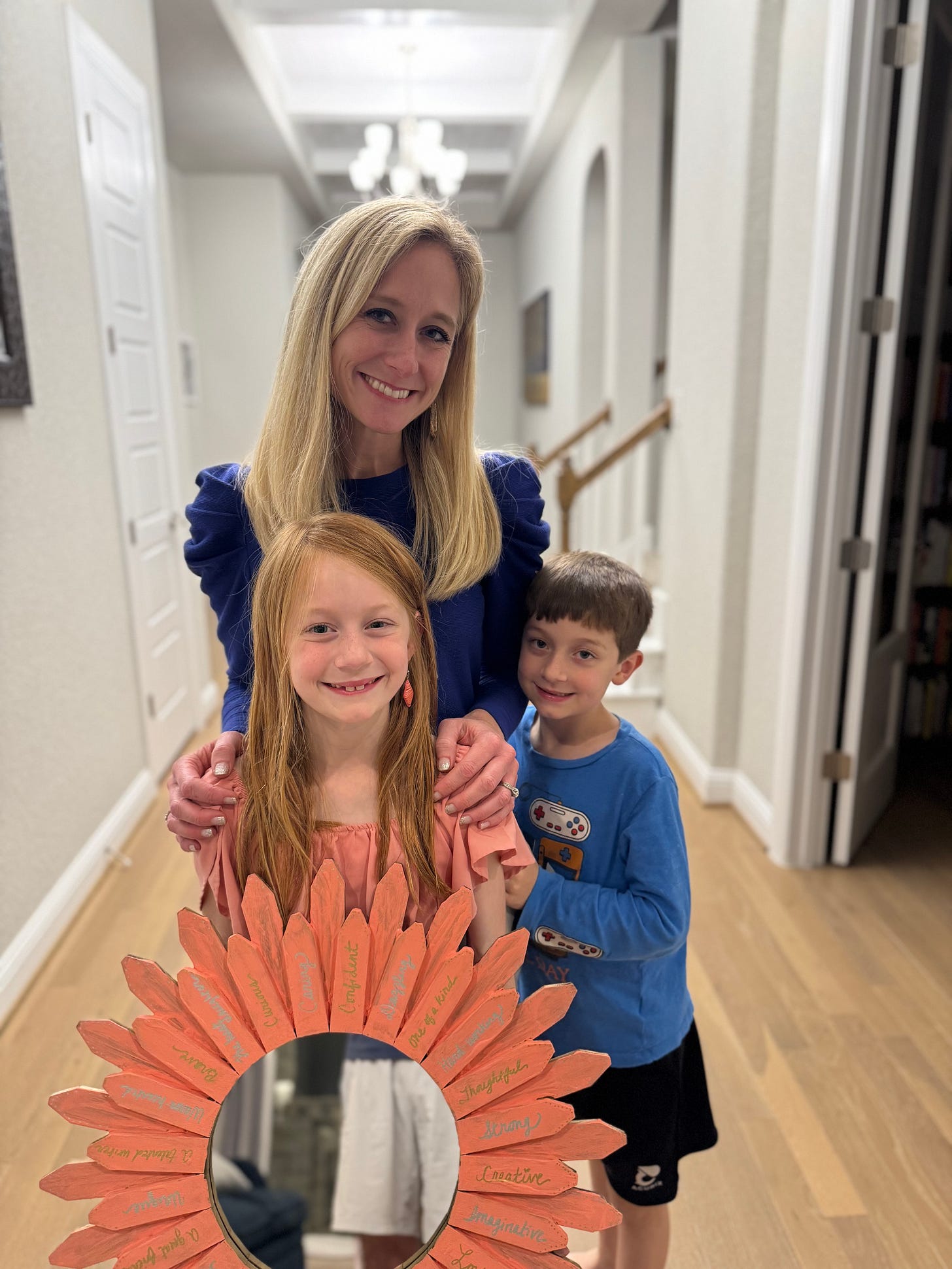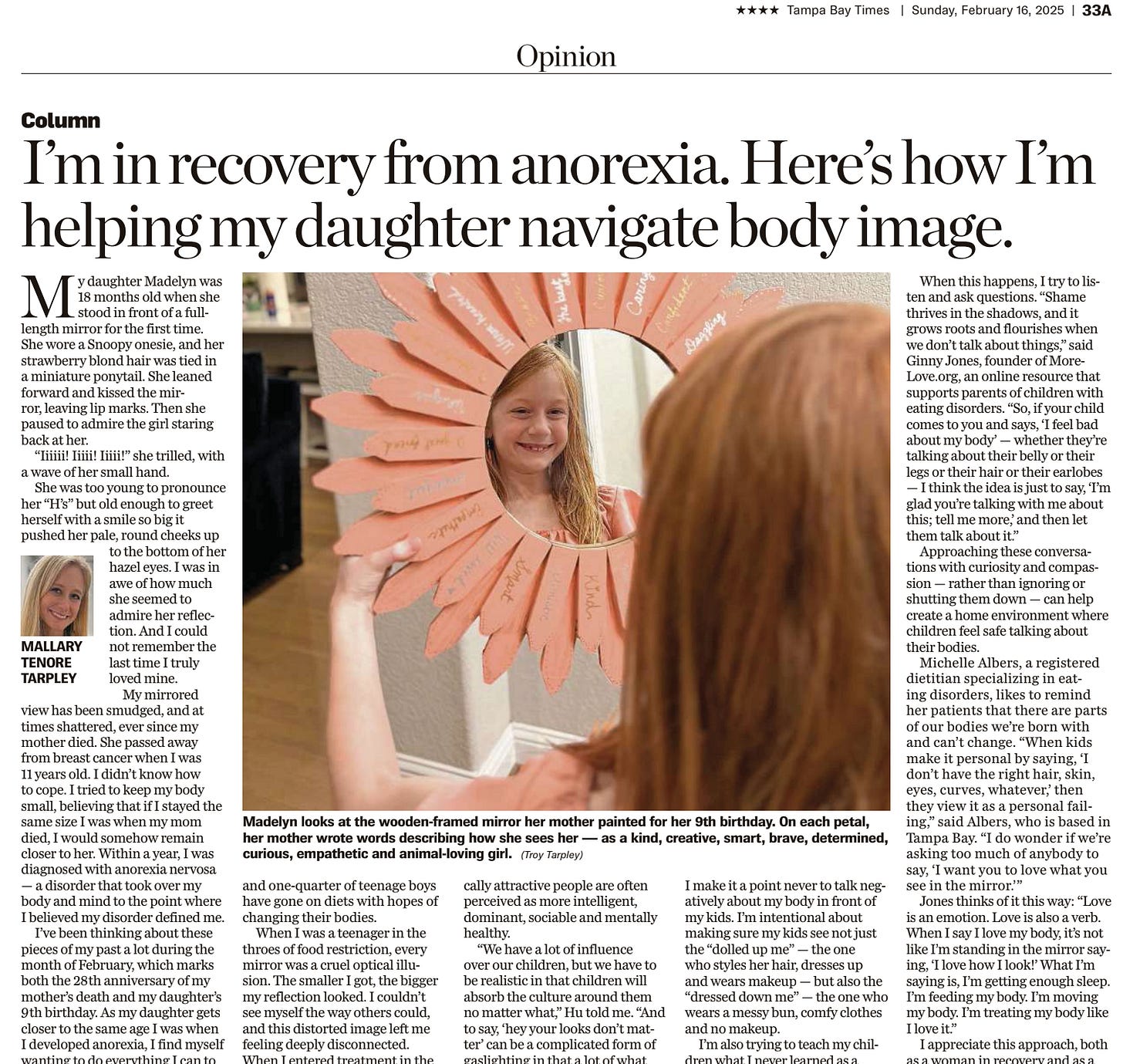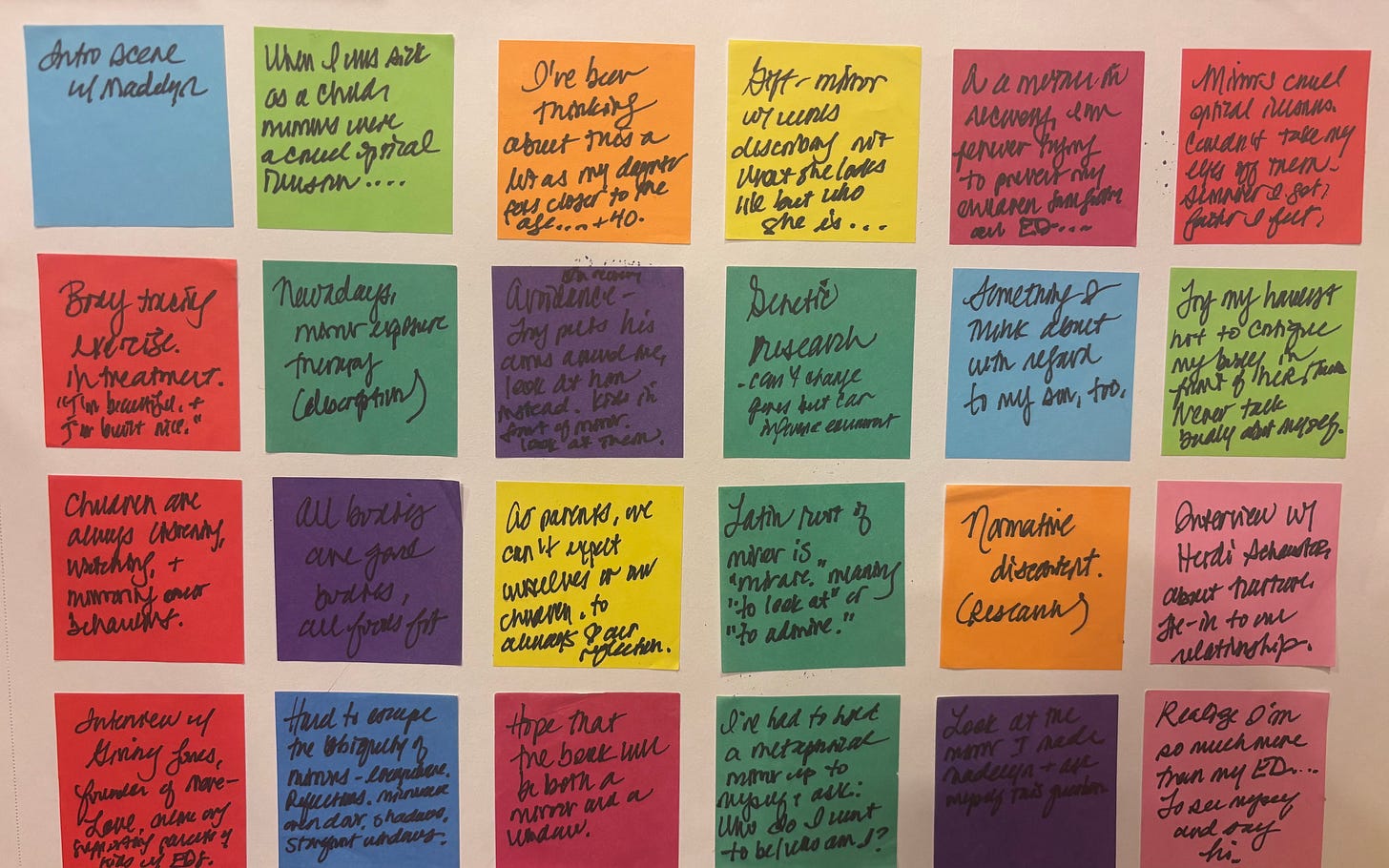One of my favorite genres is the reported personal essay. My latest one, published in last Sunday’s Tampa Bay Times, takes a close look at how I’m helping my 9-year-old daughter navigate body image as a mother in eating disorder recovery.
The piece has gotten some nice feedback from parents who said it helped them think through how to talk with their children about not just body image, but body diversity, body neutrality, and self-respect.
When reflecting on my reporting and writing process for this essay, I came up with 10 related tips that I think you’ll appreciate — especially if you’re looking to pitch and write personal essays that blend narrative, research, and interviews.
1.) Take advantage of your outtakes document.
While writing my forthcoming book, Slip: Life in the Middle of Eating Disorder Recovery, I maintained a robust outtakes document where I kept copy that I had originally included in my manuscript draft but ultimately had to cut from the final product. I hoped to repurpose at least some of the content so that it could one day exist in the world and not just on my computer.
Recently, while revisiting the document, I came across two passages that I loved. They were from the beginning and end of my book’s original prologue, which I ultimately decided to part with in favor of a longer author’s note. The passages gave me the idea for my Tampa Bay Times essay, and they ultimately served as the beginning and ending of my essay.
2.) Find a timely angle for your pitch.
Having a timely angle is one of the factors that can strengthen your pitch. The time element doesn’t necessarily have to be related to the news; it could be tied to a holiday, birthday, anniversary, etc. I pitched my latest essay in timing with the month of February, which marks my daughter’s birthday and the anniversary of my mother’s death. Because my essay focused on both my daughter and mother, this time element was relevant.
A few years ago when pitching a personal essay about vegetarianism, I realized there was a National Vegetarian Day coming up, so I pitched the piece accordingly. This was one of the factors that ultimately helped me get the piece published. Similarly, a couple years ago I pitched the Los Angeles Times on a personal essay about self-love in timing with Valentine’s Day. The editor liked my pitch, and the piece ended up getting published on Feb. 14. Sometimes you have to be creative about what constitutes “timeliness.”
3.) Identify three key sources, and name them in your pitch.
I always make it a point to do reporting for my personal essays. I do so for a few reasons: Reporting helps advance my understanding of whatever I’m writing about; it diversifies the perspectives and voices in my essays; and it extends the storyline beyond my own experiences.
Editors like knowing that you’ve done some reporting for your essay, and they like it even more when you show you’ve done your homework and identified sources to interview. My general rule of thumb is to include the names of three sources in my pitches. Most of the time, I’m only given about 1,200 to 1,700 words for a personal essay, meaning I can’t give a lot of real estate to any one source. Any more than three sources tends to be too many and can detract from the focal point of a personal essay: one’s own narrative.
4.) Do or create something as part of your essay.
For this essay, I wanted to do something to show how I’m helping my daughter Madelyn navigate body image. I decided to buy a floral-shaped mirror and decorate it for her as a birthday present. On each petal, I wrote words describing how I see her — as a kind, creative, smart, brave, determined, curious, empathetic and animal-loving girl. I wrote about how I want Madelyn to see herself — in the mirror and in life — as more than “pretty.”
Framing the essay around the act of making the mirror, and then gifting it to my daughter, helped me to explore the abstract concept of body image in a concrete way. (And it made for some great photos to go along with the story!)

5.) Find your essay’s bookends.
Whenever I write a personal essay, I ask myself: What anecdote do I want to convey at the beginning and then return to at the end? I typically incorporate personal narrative, interviews, and research into my essays, so I like to start and end each essay with an anecdote that illustrates these three elements. Scenes can be a great starting point.
In this latest essay, the opening anecdote is a scene from eight years ago, when Madelyn looked in a full-length mirror for the first time and waved to herself. In it, I included a quote so that readers could hear Madelyn’s voice and begin to identify with her as a character from the very beginning:
“Iiiiii! Iiiii! Iiiii!” she trilled, with a wave.
She was too young to pronounce her “H’s” but old enough to greet herself with a smile so big it pushed her pale, round cheeks up to the bottom of her hazel eyes.
The ending anecdote, which is from the present day, is about me looking in the mirror and acknowledging myself:
I’m a woman who can look at my reflection in the full-length mirror of life, smudges and all, and appreciate the girl I once was and the woman I’ve become. Who can see myself and say “Hi.”
The related beginning and ending acted as two sturdy bookends that hold up everything in between.
6.) Outline your work.
I’m a big proponent of outlining. I tend to start outlining pretty early on in the reporting process and then refine the structure once I’ve finished all my interviews. As a visual person, I like to write out my main points on small pieces of origami paper (or Post-it notes) and then shuffle them around until I’ve figured out the right order. Then I glue the origami to one large sheet of paper and hang it up in my office so that I can see it while writing.
I use the outline as a roadmap that guides me through the writing process. Outlining takes more time on the front-end, but it ultimately saves me time when writing.
7.) Pay attention to transitions.
When blending personal narrative and research, you can run the risk of giving readers whiplash as you move from one to the other. Rather than starting off paragraphs with wonky language like “According to research,” I try to begin sentences with personal narrative that paves the way for statistics.
For example, after a paragraph about modeling good behaviors for my children, I wrote:
I think about this a lot as a mother who still lives with my eating disorder’s imprints and who has read the research showing that females who have a relative with anorexia are eleven times more likely to develop the disorder themselves compared to individuals without a family history. Knowing I can’t influence my daughter’s genes, the pressure to positively influence her environment feels immense.
Notice how I surrounded the research with narrative — to give it more context and to make it more accessible.
8.) Play with language.
Figure out what brings you joy as a writer and have fun with it. I love alliteration, for instance, and I enjoy figuring out how to weave it into my writing. In this essay, I included alliteration in two sentences:
“At times it seems as though I’m parenting with the hope that my children will respect their bodies and with the hypocrisy of knowing I’m not always able to do the same.
“I’m also trying to teach my children what I never learned as a child — that weight stigma is prevalent and problematic.”
I also like to play with symmetry. In one sentence, for instance, I found myself wanting to include an expression that my mother used to say: “all dolled up.” I thought about what the opposite of this expression would be and settled on “dressed down.” The end result incorporated both alliteration and symmetry:
I’m intentional about making sure my kids see not just the “dolled up me” — the one who styles her hair, dresses up, and wears makeup, but also the “dressed down me” — the one who wears a messy bun, comfy clothes, and no makeup.”
Lastly, I had fun with rhyming. When writing about a message that I like sharing with my children, I found a way to make it rhyme. The rhyme seemed fitting for this one line, given that it’s geared toward a younger audience:
I remind my daughter and my son that all bodies are worthy of dignity and respect, no matter how short or tall, no matter how big or small.
9.) Remember the magic number three.
The number three is considered the “magic number’ in writing. In his book Writing Tools, Roy Peter Clark writes: “Use one for power; use two for comparison, contrast; use three for completeness, wholeness, roundness; use four or more to list, inventory, compile, and expand.” In personal essays, using three examples helps to encompass the whole.
I used the magic number three in the paragraph where I talk about body diversity:
My husband and I try to celebrate body diversity by exposing our kids to books, movies and TV shows that reflect a range of body sizes and shapes.
And I used it again in the last paragraph of my essay when describing myself as a wife, a mother, and a daughter.
I’m a wife to a husband who loves me for who I am, a mother to two strong-willed children, and the daughter of a mother who I hope would be proud of how much progress I’ve made.
10.) Convey progression, not perfection.
As I wrote my body image essay, I thought about one of my favorite quotes from author Leslie Jamison: “If you honor the complexity of your own life — if you grant us entry into moments that hold shame or hurt or heat, and if you’re willing to follow that heat, to feel out where all the small fires burn, then your readers will trust you. They’ll find flashes of themselves.”
In my essay, I tried to create this sense of trust by revealing hard truths — namely the fact that my mirrored reflection is still smudged and distorted even after all these years of working through eating disorder recovery.
The best personal essays explore moments of growth and realization, but they don’t promise a resolution, and their endings aren’t tied up with a pretty bow. Speaking truth to reality will make you more vulnerable, but it will also make your writing more real and relatable.
I’d love to hear your thoughts! Please feel free to share your own tips in the comments below.







Dear Mallory,
This piece is crystal clear ! It helps immensely. And it is so well written. Thank you.
About your published article: nothing boost more the morale to see your article well exposed and with a good title ! The frame you invented for the mirror is such a good idea. To share it with the readers is great. All the best to your daughter and son.
Magicians may not be able to reveal their secrets, but I'm so glad writers do! Thank you for sharing your process from the big picture down to the diction level. I love it!
I have one question about sources. At a writing conference, I heard a few horror stories of freelancers getting a "no" from a pitch only to find out the editor assigned a VERY similar story to someone on staff, who then used the sources named in the pitch. For pitching new outlets, I have since started saying things like "a psychologist who specializes in eating disorders" rather than naming the specific person I have in mind. Maybe I'm just being paranoid?